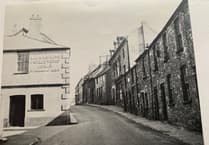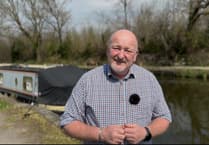It’s 1940. The country is at war. Bombs are raining down on London, Birmingham, Liverpool, Bristol, Cardiff and other industrial centres writes Dave Kent.
Graphic photos of burning buildings fill our newspapers. There are loud and eerie raid warnings, and thousands of residents of big cities rush to their nearest air raid shelter, perhaps an underground train station or some other communal haven. But along the River Wye there is another haven, in a place of peace and tranquillity, where you would not believe that these terrifying events were taking place. By the River Wye, far from these metropolitan horrors, there is a haven of serenity that the war has evaded.
I’ve unearthed a long-forgotten painting in my collection entitled ‘Brockweir’ by Norman J Williams, a bright panorama of a peaceful riverside village painted during times which were definitely not peaceful during the Second World War. It depicts, from a viewpoint on the other side of the River Wye, the village in 1940. The view is almost the same as it is now, with the high hills of the Devils Pulpit and the woods around Offa’s Dyke Path in Tidenham Chase over in Gloucestershire in the background. The River Wye flows gently through the view. My copy is number 105 in a limited edition of 250, and I’ve had no luck in trying to identify the painter Norman J Williams.
This idyllic rural view is somewhat compromised by the appearance of a smoky old steam train passing by the painter on its journey from Chepstow to Monmouth. It’s a strange feature of this landscape, but the train somehow seems to fit into this pastoral scene. There is an old iron bridge across the river in the foreground. It isn’t a railway bridge, as the rail track crosses the river further downstream at Tintern, but it’s where the existing minor road from Hewelsfield through Brockweir crosses the river to meet the A466 Chepstow to Monmouth road. Sadly, this view is no longer available, as an intrusive plantation of trees on the Gwent side just north of the road bridge has now obscured this view from this point.
The smoky train is on its way from Chepstow to Monmouth, but its route takes it across to England on its track from Chepstow to Tintern. The track from Chepstow crosses the Wye, goes through Tutshill, over a railway bridge which still exists on the A48 Chepstow to Lydney road, past where the National Diving Centre used to be, and enters a tunnel at Netherhope, a remote and underpopulated area where there was once a railway halt. There cannot have been much passenger traffic there. Poet Edward Thomas wrote of Adlestrop railway station in the Cotswold Hills that ‘No-one left and no-one came on that bare platform’, and that could equally well apply to Netherhope. The tunnel is now a walking/cycling path. It emerges at the Wye opposite Tintern, where the now dismantled bridge took trains back across the Wye to Tintern Station, which is now a great regional tourist attraction, the renovated Old Station Heritage Park. The Heritage Park is a great place for a gentle riverside walk, which takes you upstream to the Brockweir bridge, and then down to a surviving former railway bridge in Tintern, and past the charming St Michaels Church and back along the open meadows of Tintern Parva to the Heritage Park. From there, the train would chug along to where Norman J Williams painted it, and then onto St Briavels Station, where, if it was an early morning train, it would drop off the morning newspapers for St Briavels newsagents to collect. St Briavels Station house, severely dilapidated after 66 years of disuse, can still be seen by the A466 at Bigsweir Bridge.
The old, now completely dismantled rail track keeps to the west side of the river to Penault, where it crosses the Wye to Redbrook. The bridge is still available for pedestrians, but sadly, the Boat is only accessible to vehicles from Redbrook through a 10 mile drive through Monmouth and back on the Gwent side of the river to Penault.
The pubs at Redbrook a few years ago were the 3 ‘Bs’, the Bell, the Bush and the Boat, although the Bell is now no more and the Boat is in Wales, but it was and is very accessible to thirsty walkers in Redbrook. The rail track goes on upstream to cross the Wye again for its final bridge to Monmouth.
Viewing the peaceful rural scene in Norman J Williams evocative painting, it is difficult to imagine that Brockweir was, until the early 20th century, a busy port on the Wye, with riverside trading links to Bristol, and it was a shipbuilding centre. Its industrial and commercial days are now over, and it is now known for its Moravian church, its compact, quaint and traffic-less hidden village centre, its long term 20th century residence of the childrens’ author Flora Klickmann, and now for the indefatigable efforts of its residents to restore the Brockweir Inn, which should be completed soon.
The village, when it was a busy working village, had many pubs in its industrial days, but can no longer support them. The Brockweir Inn, the only surviving pub in the village, was a stop on the epic walk of Offa’s Dyke Path completed by my wife Ann and myself in 1989, where we enjoyed our lunch break on the first day of our walk from the Severn at Beachley to the north Wales coast. I look forward to retracing some of those steps, revisiting that charming village pub the Brockweir Inn when it reopens, and enjoying ‘a rural scene, a rural scene, a sweet especial rural scene’, as the poet Gerard Manley Hopkins, the 19th Century poet, might have described it. It’s a sweet especial rural scene enhanced by a lonely train puffing its way through the peaceful village.
*Do you know the artist Norman G Williams? If you drop us an email at [email protected] and we can pass the information on to Dave Kent





Comments
This article has no comments yet. Be the first to leave a comment.